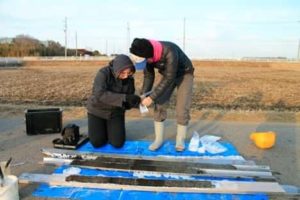
Researchers have discovered geologic evidence that unusually large earthquakes and tsunamis from the Tokyo region — located near tectonic plate boundaries that are recognized as a seismic hazard source — may be traceable to a previously unconsidered plate boundary. The team, headed by Simon Fraser University Earth scientist Jessica Pilarczyk, has published its research today in Nature Geoscience.
The team’s ground-breaking discovery represents a new and unconsidered seismic risk for Japan with implications for countries lining the Pacific Rim, including Canada.
Pilarczyk points to low-lying areas like Delta, Richmond and Port Alberni as potentially vulnerable to tsunamis originating from this region.
In 2011, eastern Japan was hit with a massive magnitude 9 quake — creating the largest rupture area of any earthquake originating from the Japan Trench. It triggered the Fukushima Daiichi nuclear disaster and a tsunami that travelled thousands of miles away — impacting the shores of British Columbia, California, Oregon, Hawaii and Chile.
For the past decade, Pilarczyk and an international team of collaborators have been working with the Geological Survey of Japan to study Japan’s unique geologic history. Together, they uncovered and analyzed sandy deposits from the Boso Peninsula region (50 km east of Tokyo) that they attribute to an unusually large tsunami that occurred about 1,000 years ago.
Until now, scientists did not have historical records to ascertain if a portion of the Philippine Sea/Pacific plate boundary near the Boso Peninsula was capable of generating large tsunamis similar in size as the Tohoku event in 2011.
Using a combination of radiocarbon dating, geologic and historical records, and paleoecology, the team used 13 hypothetical and historical models to assess each of the three plate boundaries, including the Continental/Philippine Sea plate boundary (Sagami Trough), the Continental/Pacific plate boundary (Japan Trench) and the Philippine Sea/Pacific plate boundary (Izu-Bonin Trench) as sources of the 1,000-year-old earthquake.
Pilarczyk reports that the modeled scenarios suggest that the source of the tsunami from 1,000 years ago originated from the offshore area off the Boso Peninsula — the smallest of which (for example, possible earthquakes with the lowest minimum magnitude), are linked to the previously unconsidered Izu-Bonin Trench at the boundary of the Philippine Sea and Pacific plates.
“Earthquake hazard assessments for the Tokyo region are complicated by the ‘trench-trench triple junction’, where the oceanic Philippine Sea Plate not only underthrusts a continental plate but is also being subducted by the Pacific Plate,” says Pilarczyk, an assistant professor of Earth sciences at SFU who holds a Canada Research Chair in Natural Hazards. “Great thrust earthquakes and associated tsunamis are historically recognized hazards from the Continental/Philippine Sea (Sagami Trough) and Continental/Pacific (Japan Trench) plate boundaries but not from the Philippine Sea/Pacific boundary alone.”
Pilarczyk hopes that these findings will be used to produce better informed seismic hazard maps for Japan. She also says that this information could be used by far-field locations, including Canada, to inform building practices and emergency management strategies that would help mitigate the destructive consequences of an earthquake similar to the one of 1,000 years ago.
Reference:
Jessica E. Pilarczyk, Yuki Sawai, Yuichi Namegaya, Toru Tamura, Koichiro Tanigawa, Dan Matsumoto, Tetsuya Shinozaki, Osamu Fujiwara, Masanobu Shishikura, Yumi Shimada, Tina Dura, Benjamin P. Horton, Andrew C. Parnell, Christopher H. Vane. A further source of Tokyo earthquakes and Pacific Ocean tsunamis. Nature Geoscience, Sept. 2, 2021; DOI: 10.1038/s41561-021-00812-2
Note: The above post is reprinted from materials provided by Simon Fraser University. Original written by Diane Mar-Nicolle.










